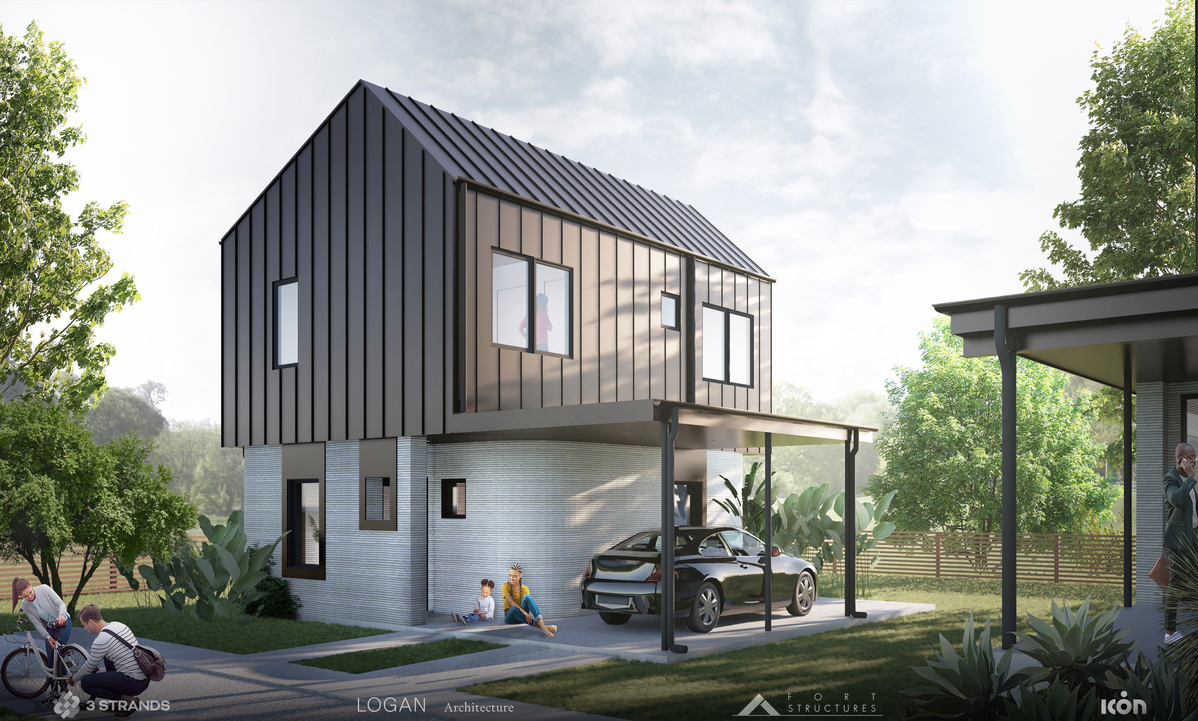
The exterior rendering of a 3D printed home being built by the construction technologies company ICON Kansas City-based developer 3Strands in Austin, Texas. [Photo/Courtesy of Logan Architecture]
In some of the hottest US housing markets, 3D-printed houses are competing against traditional wood-frame houses with developers touting "cheap", "safe" and "eco-friendly" features.
The US housing market has flourished since the COVID-19 pandemic depressed housing inventory last year, and new buyers are driven by low mortgage rates and the ability to work remotely.
In Riverhead, New York, on Long Island, a 3D-printed house with three bedrooms, two bathrooms and a 2.5-car detached garage is listed for sale through Zillow with an asking price of $299,999.
The house will be built with concrete by SQ4D, a New York-based construction technology company using an "Autonomous Robotic Construction System".
It is touted on the company's website as "the first 3D-printed home slated to receive a certificate of occupancy" in the US.
The company said its patent-pending technology lays concrete layer by layer, robotically building the footings, foundations, interior and exterior walls on site. It offers a 50-year limited warranty on the 3D-printed structure.
Stephen King, the Zillow agent who has the listing, said the price is 50 percent below the cost of "comparable newly-constructed houses" in the area, according to SQ4D's promotion on its website.
In Austin, Texas, another construction technology company, ICON, also claims to have America's first 3D-printed homes for sale. Partnering with Kansas City developer 3Strands, the company is building two-to-four-bedroom homes in Austin, the Texas capital.
ICON's 3D printer — "Vulcan" — is almost 12 feet tall and is 33 feet wide. It can print walls up to 8 feet, 5 inches tall and foundations up to 28 feet wide.

The construction site of a 3D printed home in Austin, Texas. The multi-home project, launched by the construction technologies company ICON Kansas City-based developer 3Strands this month, is now for sale. [Photo/Courtesy of ICON]
The 3D-printing construction technology can "precisely control the deposition on concrete over a large print area", so it can build a house in weeks, the company said.
The technology will help address the "extreme lack of housing that has left us with problems around supply, sustainability, resiliency, affordability and design options", said Jason Ballard, CEO of ICON.
ICON also partnered with the non-profit organization New Story on a 3D-printed housing project in an impoverished, rural part of Mexico in 2019, according to CNN, which called the project "the first 3D-printed neighborhood in the world".
In the US, the first 3D-printed housing community will be built in Rancho Mirage, a desert resort city in California, according to developer Palari.
It covers 5 acres, includes 15 houses and is set for completion by next spring. Each house has three bedrooms and two bathrooms on a 10,000-square-foot lot with a swimming pool and deck for $595,000.
All the houses will be made from 3D-printed panels by Mighty Buildings, an Oakland, California-based construction technology company.
The company uses panelized technology, called the "Mighty Kit System", to print a "stone-like" material. Unlike SQ4D and ICON, which work on the building site, Mighty Buildings ships the panels to the site, where they are assembled.
The houses in the Rancho Mirage project will take a month to install as opposed to three to six months using traditional methods, Palari CEO Basil Starr told the Los Angeles Times. A typical project of this scale would take around three years, but they are planning for no more than a year and a half, he said.
The pre-sale campaign started in late February and sold out within days, said Starr, adding that most of the buyers were tech-savvy millennials with a passion for sustainability.
Apart from the construction speed, the companies also emphasize that 3D printing is more eco-friendly than conventional building methods because 3D printers generate the precise amount of material, while building wood-frame houses will result in construction debris ending up in landfills.
The 3D-printing technology also provides "safer, more resilient" houses that are designed to withstand fire, flood, wind and other natural disasters better than conventionally built houses, according to ICON.